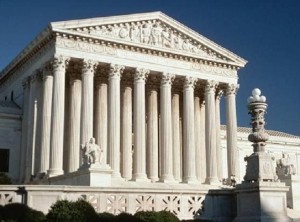By MARK GRUENBERG
PAI Staff Writer
 Washington (PAI) – Skeptical U.S. Supreme Court justices, delving into arcane questions such as when the U.S. Senate is in recess – or not – tackled the issue of when the President may fill vacancies on the National Labor Relations Board and elsewhere in the government, so that government can function.
Washington (PAI) – Skeptical U.S. Supreme Court justices, delving into arcane questions such as when the U.S. Senate is in recess – or not – tackled the issue of when the President may fill vacancies on the National Labor Relations Board and elsewhere in the government, so that government can function.
But at the heart of the dispute, though it was scarcely mentioned during almost two hours of questioning on Jan. 13, is a political war, pitting Senate Republicans, determined to sabotage not just the NLRB but the entire Obama administration, against the President. The NLRB just happened to be the chosen battleground.
The case, National Labor Relations Board vs. Noel Canning is important to workers because it goes directly to the question of whether and when the NLRB can function and thus judge worker-boss disputes. If it can’t, justice in the workplace stops.
‘RECESS APPOINTEES’
Yet that point wasn’t mentioned in the debate in the Supreme Court chamber.
Instead, the justices quizzed the lawyers about when the President has the power to fill vacancies, both at the NLRB and elsewhere, with “recess appointees” – as Obama did at the labor board – during a three-day Senate recess in January 2012, even if the Senate says it’s not in recess, which it had.
The Constitution gives the President power to make recess appointments. The company, its business backers and the Senate GOP argued that if the Senate says it’s not in recess, the President can’t act, ever. Obama said he can.
Obama had to make those appointments because GOP filibusters blocked his regular NLRB nominees and brought the board to a halt – a point that Solicitor General Donald Verrilli, speaking for the administration, never mentioned.
But because the Senate was still in session between those recesses, with one senator coming in every three days, banging the gavel to open the Senate and then banging it to quit, just a minute later, the recess appointments are illegal, said Noel Francisco, the lawyer for the canning company.
The firm had lost at the NLRB when the board ruled 3-0 in its struggle with Teamsters Local 760 over contract enforcement, but two of the three were “recess appointees.” The firm won in lower courts by saying they were illegal and thus their decision was illegal. Some 1,000 other firms have since used the same defense.
DIMINISHED AUTHORITY
Upholding the firm’s stand “would diminish the President’s authority in a way that is flatly at odds with the constitutional structure the framers established” in 1787, Verrilli told the justices. “There are many hundreds of board decisions that are under a cloud as a result” of the lower court ruling backing the canning company, he added.
“You don’t think we’re going to go back and rip out every decision?” by the NLRB while the recess appointees sat, Justice Stephen Breyer asked. “I certainly hope not,” Verrilli replied.
Verrilli kept making the point that for more than 200 years, Presidents made recess appointments when the Senate wasn’t in session and that senators did not challenge them. The practice started to change in the last decade or so, he added, when the Senate started taking short three-day recesses.
The company also argued, and the lower court agreed, that recess appointees, and their rulings, are illegal, regardless of whether the recess was three days or longer.
Francisco stuck to the basic proposition that the Senate wasn’t in recess, since it was meeting every three days for the 1-minute sessions, so the NLRB recess appointments – and others – are illegal.
At least one justice, Breyer, suggested that no matter which way the court rules on the constitutional issue, the NLRB may be able to solve the practical matter of what to do about the 1,000 cases where businesses have challenged its power to rule at all.
The justice noted the High Court ruled before, also upholding a lower court decision by pro-GOP judges, that the NLRB lacked a quorum to decide cases. The board later went through all those cases and re-ruled on them, he said. It could easily do so again, “but it would just mean more work” for the board, Breyer added.
The justices will rule on the case by the end of June.

